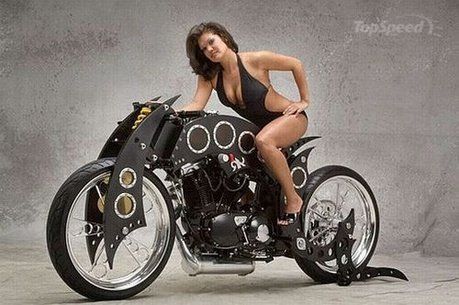|
|
|---|
Wednesday, May 12, 2010
WORLD EXCLUSIVE - FIRST RIDE ON THE KESTREL
Sometimes a scoop is a whispered favor, and sometimes you just grab it with both hands and go.
I had the great luxury of spending last weekend in the company of the whole Falcon Motorcycles ouevre; the Bullet, the Kestrel, Ian and Amaryllis, the talented trio of fabricators from Falcon, and Leif who built up the engine, at the Quail Lodge for the Motorcycle Gathering.
I've had the rare opportunity not only of having (well, hijacking) the first real ride on the Kestrel, but of watching the entire process of its development from a sketch through 'wouldn't these parts look cool if I mated them this way' to firing up the bike and easing the clutch home.
And what a thing Ian Barry has created.
It has broken the bounds of 'Custom' into some new category. Ian Barry is no longer a Custom builder, he's graduated to a motorcycle designer, and the Kestrel is his masterpiece.
When I first saw the Bullet while judging at the 2008 Legends, I thought it was a well-executed Custom, worthy of praise, and thus tolerable to a Vintagent who had little interest in the genre per se, but certainly an appreciation of good workmanship and passion.
The Kestrel is different.
Ian Barry has shown there is Vintage blood running in his veins, plus something else, but I'll let history name that. Mark my words, it will. I'll stake a claim here and now that the Kestrel has broken out of the Custom shell, and has become something completely new. This man and his team made a Motorcycle the world will have to reckon with.
I was interviewed last week for Wired magazine about the new Brough Superior project, the technical issues to overcome when building a contemporary motorcycle from an old design. We spoke at length about modern materials and old skills required to make an air-cooled engine with limited lubrication run well and durably. I mentioned the ethos of George Brough, which was to build a 'money is no object' motorcycle to his exacting standards, and how the new Brough Superior is built to such a standard. The reporter asked if any other manufacturers used this credo today. I had to think hard, as of course, no production motorcycle can be built to such standards with any hope of financial survival.
The only people with the dedication to build completely over-the-top motorcycles in terms of labor cost are making Customs these days. Not the bolt-up or raked-out variety, but the true artisans who spend countless hours pursuing their unique vision of what a motorcycle can be. Kimura, Nogata, Barry, and a handful of others. The outer form may be similar to other machines; the great qualitative difference is Time. No shortcut in machining or bolting on a stock part can replace hundreds or thousands of hours of skilled handwork. It's a difficult path to walk, and there's no guarantee that even those established in this rarified air can remain there indefinitely, as economic realities, like the weather, are not subject to our will or wishes.
Having had the great luxury of observing the Kestrel's full spectrum of development from idea to metal, I 'knew what to expect' when the machine was finally unveiled. And when I saw the post-painting photos, I thought it very well done indeed, but was hoping for a little more flash. After all, it was supposed to be a Custom.
That statement may come as a bit of a shock to my friends at Falcon, but I hope they understand. I've made a point in the last 25 years to own the motorcycles which I thought were the most beautiful in the world, and my standards have been high; four Broughs, and a lot of racing bikes - Nortons (Manx, Inters, flat-tankers, twins), Velocettes (KTTs from '29-'49, Thruxtons et al), Sunbeams (TT90, Longstroke), Scotts (ex-Works '29 TT), BMW (R63, R68, R69, R51racer), Rudge ('29 Ulster). A supercharged Zenith for cryin' out loud...something like 300 bikes passed through my garage in that period. What I couldn't find or afford, I borrowed rides on, some of which I've been privileged to share via The Vintagent's 'road test' series.
So I spent more time with the Kestrel, and each time I looked I found something new. A funny little gearbox adjuster, with positive stops and a brace to prevent any axial play. An internal throttle which exits through the end of the clip-on handlebar, with a knurled cable adjuster fixed unobtrusively in place. The little locking levers on top of the TT carbs, which adjust the idle speed. The brackets which hold the two pannier tanks together, which are...turnbuckles... and adjustable to be sure the tanks will fit together just so. An articulated shifter mechanism which mimics the fine bones of the inner ear.
And gradually, I was awe-struck.
The Kestrel isn't a first-look or a ten-foot motorcycle, it's a third look machine, or a fifth. Like a work of fine art, it needs to be lived with to soak it in. It rewards time with time, those thousands of hours spent on its creation slowly leak back out, if you let them. It's a monumental achievement, and among the most beautiful two-wheelers ever made.
Stick it on a shelf with a 1926 SS100, the blown AJS ohc twin, the NSU Rennmax, the icons, the great ones. If I were a wealthy man, I would buy the next Falcon. As it is, we'll just have to wait and see how the Vincent 'Black' Falcon turns out. Ian may make better machines in the future, or lesser, but we have the Kestrel, and it is the new standard.
OK, enough love poem, clearly I'm smitten. I was also the first person to RIDE the Kestrel for any distance, as it was finished a day before the Quail with many, many sleepless nights spent fabricating the pieces in the previous months. The 'World Exclusive' etc wasn't my intention, I simply found myself having been granted permission to try the Kestrel, with a running engine between my legs, and an open lawn. 'First gear is really tall' is all Ian said, but I knew the clutch was built for triple the horsepower, so a little slippage wouldn't harm things. As I blatted the throttle and a glorious rasp barked from the two-into-one open megaphone (hand shaped by Ian into a fish mouth), it occurred to me that a ride around the golf course, fun as that sounds, wouldn't tell me what I needed to Know.
Does it work? Or like Mona Lisa, is it a lovely work of Art? I had reconnoitered the field access a bit earlier by riding my late-entry (ie, no entry, and at noon) '28 Sunbeam TT90 from the street onto the lawn, and thank you Courtney Porras for telling Quail security that I could 'do whatever I want'. Give a man an inch! Thus I knew it was perfectly possible to ride the bike straight from the grass to the road, and nobody would stop me. Up the grassy slope - road clear - and off I went, first right, to all smiles from the hundreds of motorcyclists parked up along the street, and back again to the left, where the highway beckoned.
The private drive of the Quail is a couple of miles long, and has a mix of bends and straights, before connecting with legendary Carmel Valley Road. The TT carbs weren't 100% sorted (I had been warned of this earlier), so the engine stumbled just off idle, then cleared up as the revs rose. It was easier just to twist the throttle and have at it, let the machine have its head, while risking my own. No, I wasn't wearing a helmet (one doesn't, typically, when emcee of an event) or gloves, but this was the Moment, and I was taking it all the way.
Full throttle through the gears, but the engine had less than a mile on it, so no need to find top speed. That will happen at Bonneville this year, anyway; not my job. Around the bends, with a few bumps and undulations and a rising throttle, the Kestrel behaved flawlessly, and I watched the forks Ian built move up and down smoothly. While cranked over, the bike felt rock solid, yet light, nimble, and flickable. The brakes were really good, better than any of my drum braked machines anyway; the clutch was light, the gear selection with that delicate shifter mechanism was easy and positive.
Surprise, the Kestrel is easy to ride, no excuses necessary, it works beautifully as a motorcycle, and felt for all the world like the big brother of my favorite bike of all time, 'The Mule', my '33 Velocette KTT - a truly magic machine which will leave my hands when they've gone cold. I would have liked a longer ride, but I was aware that the Kestrel isn't mine by a factor of 200,000, and would be missed if I didn't get back soon. Plus, we had strayed onto the public highway, and were illegal in ways foreign even to my lax standards. So a victory lap around the grass was in order, and the smile hasn't left me yet.
Subscribe to:
Post Comments (Atom)





















No comments:
Post a Comment